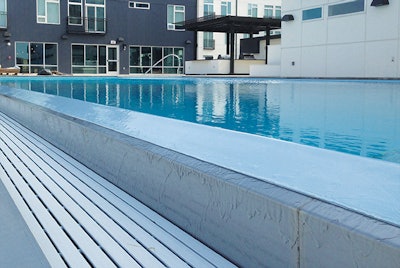
Pools and spas that never touch the ground can be both challenging and risky to install. The elevation itself is, of course, a big part of what makes these installs so complex, but there's also the building's structural integrity to consider. Leaks are a major risk factor in such projects — just imagine what could happen if an elevated pool leaked into the floors below.
Overcoming those obstacles requires working to an elevated standard of construction, as well as possibly turning to materials other than concrete.
GROWING DEMAND
As is true of most segments of the pool and spa industry, elevated pools have experienced significant growth in recent years. Gary Novitski, vice president of commercial sales and design for RenoSys, a manufacturer, distributor and installer of pool renovation and construction systems, has noticed they are often used to attract tenants to urban properties.
"With the economy going strong, we're seeing people building housing — and in many places, trying to motivate people to move back into cities," he says. "Properties are growing up and not out. If you put a pool in the ground, it takes up a lot of real estate, but obviously not if you put it up on the roof."
RELATED: As Light As Foam
RenoSys has offered stainless-steel vessels since 2006. Their pools are all individually designed and shipped in large panels that are welded together on site, as well as plumbed. In addition to traditional pools, the company also builds spas, hydrotherapy pools, cold pools, shallow tanning shelves and other decorative water features. In all, about 10 percent of RenoSys' elevated projects are something other than just a pool or spa.
"Property owners are adding an amenity they feel they need to be competitive," Novitski says. "We're seeing these pools mostly in multi-housing units in downtown areas. It's more and more part of the plan to have some sort of water element, whether it's a pool, spa, a decorative fountain or a sun deck with very shallow water, or some combination of those features."
Generally speaking, Novitski says elevated pools are commonly geometric in design and tend to be smaller, with a typical pool measuring 40 by 20 feet. (The company's largest installation was 75 by 40 feet.)
"Space is usually at a premium, and the pool is only part of the environment," he says. "It's an amenity and often not the main focal point of the setting."

All photos courtesy of RenoSys
A STAINLESS ADVANTAGE
Although some elevated pools are made with gunite or poured-in-place construction, Novitski is among those who firmly believe in the advantages of stainless steel in above-grade settings.
"A concrete pool can be as much as 10 times the weight of a stainless-steel pool," Novitski says. "Because stainless steel shells are much, much] lighter, you save money on the structure to support it. A stainless-steel pool can be built right into the deck and then you use pedestal pavers to bring the deck up to the level of the pool. You can also put the pool directly on I-beams. Overall, the stainless-steel shell is very feasible in that kind of environment."
He also points to ease of construction as a big advantage. "It's much more streamlined and very cost effective," he says. "You're not susceptible to mistakes in the concrete mix with the moisture content, which can happen you have to pump it up several floors. That can lead to cracking and leaking later on, which is a serious problem in elevated pools. There are a lot of builders who don't want to work with elevated concrete pools because when they fail they're on the hook for it."
In addition, the RenoSys method of onsite assembly is flexible, with builders able to make changes and adjustments on site far more easily than they could with fully prefabricated pools.
"What can happen is the vault that the pool is to be installed inside is not the exact dimensions or it's not level and the pool doesn't fit somehow," Novitski says. "So, then you have stop work, there's a change order and the entire construction process grinds to a halt. It can be very expensive and time consuming. When we show up and there's a discrepancy we can make adjustments right there on site."

All photos courtesy of RenoSys
WATER TIGHT
As mentioned above, leaks are a primary concern for any elevated pool or spa. If and when a leak occurs, it can spell disaster if the water invades adjacent residential or commercial spaces.
According to Novitski and other stainless-steel proponents, there is far less risk of leaks due to the impenetrable nature of the material. "There is a slim-to-no chance that a weld is going to leak," he says.
Still, concerns over leaky plumbing do necessitate some form of protection. "We suggest it, whether it's a catch pan with a drain or in a concrete vault. Most of these pools are outdoors and have deck drainage already, so usually it's not a huge issue to tie into those drainage systems. The building is going to be designed up front to account for it."
RELATED: Indoor Pools, Potential Problems?
Finally, elevated pools present the challenge of locating the equipment room, which can be a battle because space is often at a premium. Novitski reports that most of the time they can establish space on the floor just below the pool, but not always.
"We did one project where the equipment was 10 stories below the pool," he recalls. "That was a challenge making the system work hydraulically, having to pump the water that far vertically.
"There are always challenges," he adds, "but with the stainless-steel structures we're able to solve the problems you find in these types of installations. And, if these pools are properly maintained, they will last indefinitely."












































